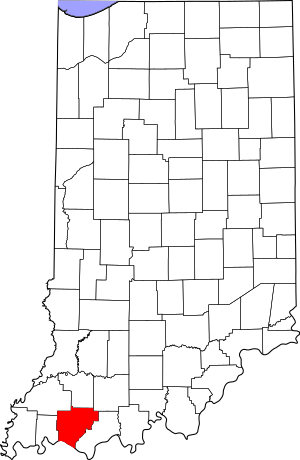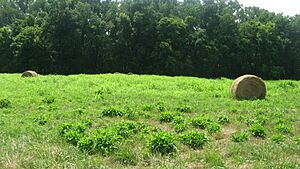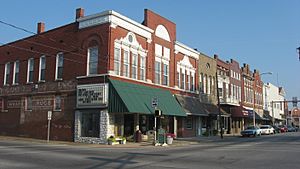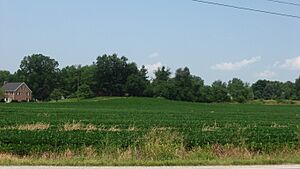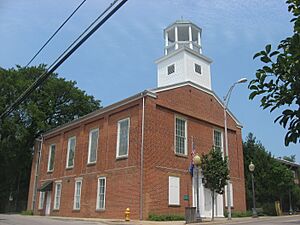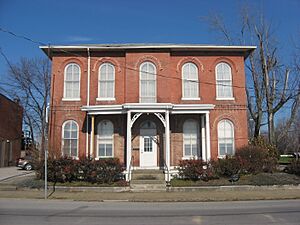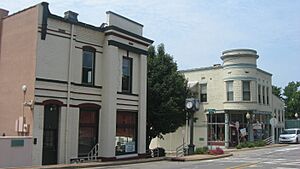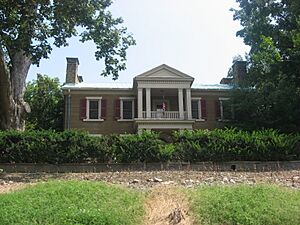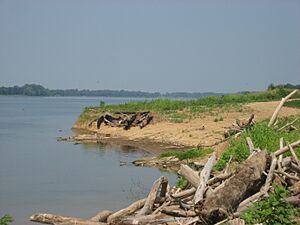National Register of Historic Places listings in Warrick County, Indiana facts for kids
Have you ever wondered about old buildings or special places that tell a story about the past? In Warrick County, Indiana, there are 8 amazing spots that are so important, they're listed on the National Register of Historic Places. This is like a special list kept by the United States government to protect and celebrate places that are important to American history, architecture, archaeology, engineering, or culture.
When a place is on this list, it means it's recognized as a valuable part of our heritage. It helps people learn about the past and makes sure these places are preserved for future generations. Some of these places are single buildings, while others are entire areas with many historic buildings, called "historic districts." Let's explore some of these cool historic spots in Warrick County!
Historic Places in Warrick County
Angel Mounds
Angel Mounds is a super important place because it's an ancient Native American town! It was once home to thousands of people from the Mississippian culture, who lived here between 1000 and 1450 AD. They built large earth mounds, which were used for homes, temples, and ceremonies. This site helps us learn a lot about how early people lived in Indiana. It was added to the National Register on October 15, 1966.
Boonville Public Square Historic District
Imagine a town square surrounded by old, beautiful buildings. That's what you'll find in the Boonville Public Square Historic District! This area in the heart of Boonville shows what a busy town center looked like many years ago. It includes buildings roughly bounded by 1st, Sycamore, 4th, and Walnut Streets. It became a historic district on January 23, 1987.
Ellerbusch Archeological Site
The Ellerbusch Archeological Site is another fascinating place that tells us about early human history. It's located on a bluff northwest of Newburgh, near State Road 662 and Ellerbusch Road. Archaeologists study sites like this to find artifacts and clues about the people who lived there long, long ago. This site was added to the National Register on March 14, 1991.
Old Newburgh Presbyterian Church
The Old Newburgh Presbyterian Church is a beautiful historic church building located at N. State and W. Main Streets in Newburgh. Churches often play a big role in a community's history, and this one is no exception. Its architecture and long history make it a special landmark in Newburgh. It was listed on the National Register on May 23, 1978.
Old Warrick County Jail
Even old jails can be historic! The Old Warrick County Jail, located at 124 E. Main Street in Boonville, was once where the county kept its prisoners. While it's no longer used as a jail, the building itself is a piece of local history, showing how public buildings were designed and used in the past. It was added to the National Register on February 14, 1979.
Original Newburgh Historic District
Just like Boonville, Newburgh has its own historic district! The Original Newburgh Historic District includes a large area roughly bounded by State Road 662 and Water, Monroe, Main, and Middle Streets. Walking through this district is like taking a step back in time, with many old buildings that show the town's early development. It became a historic district on June 16, 1983.
Roberts-Morton House
The Roberts-Morton House is a historic home located about 1.5 miles east of Newburgh on State Road 662. Old houses like this often have unique architectural styles and stories about the families who lived there. They give us a glimpse into daily life from a different era. This house was listed on the National Register on December 16, 1974.
Yankeetown Archeological Site
The Yankeetown Archeological Site is another important spot for understanding the ancient history of Warrick County. It's located along the Ohio River bank in Anderson Township, south of Yankeetown. Archaeological sites are like giant puzzles, and each piece found helps scientists learn more about the people and cultures that existed long before us. This site was added to the National Register on February 28, 1979.


